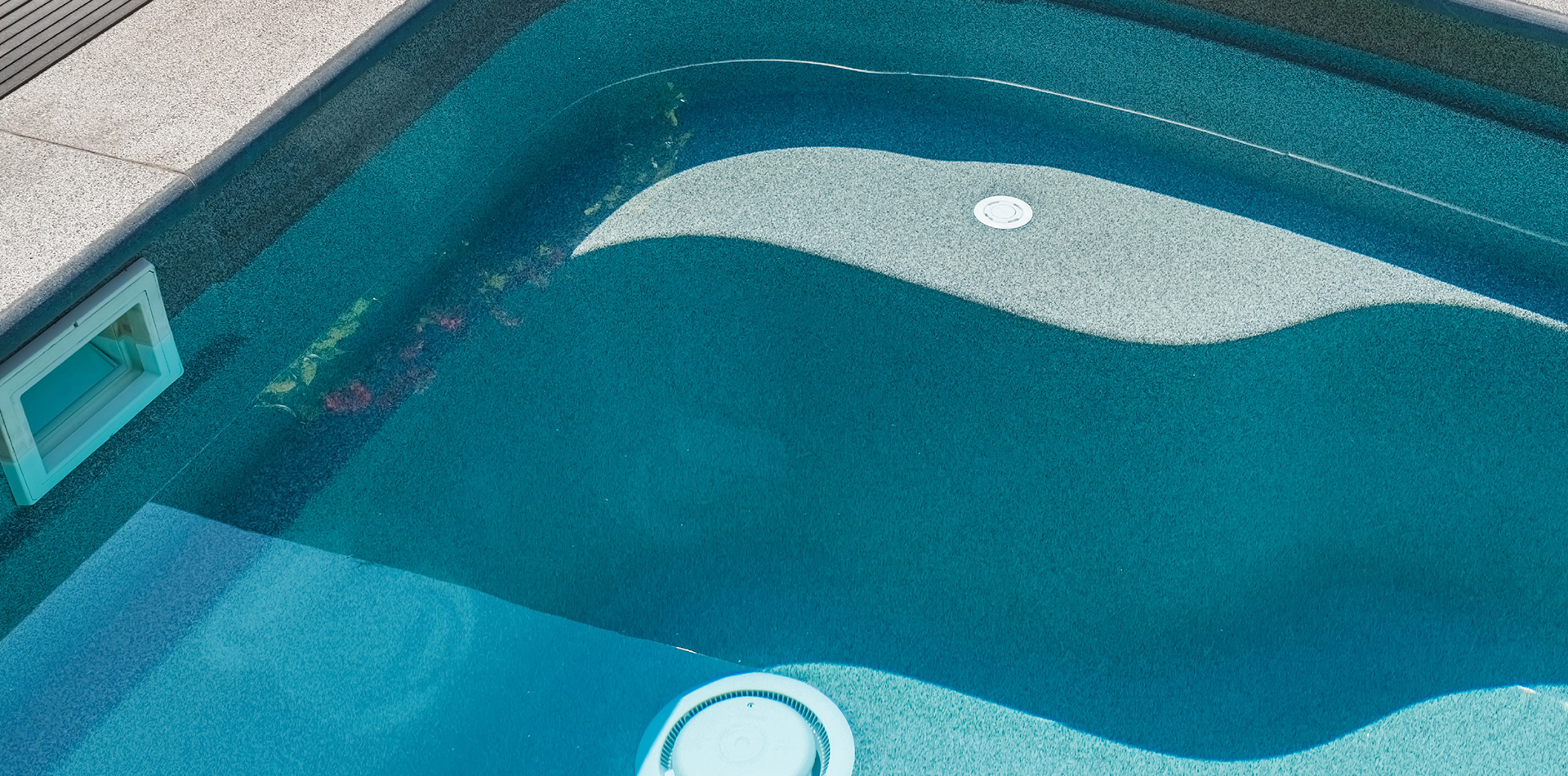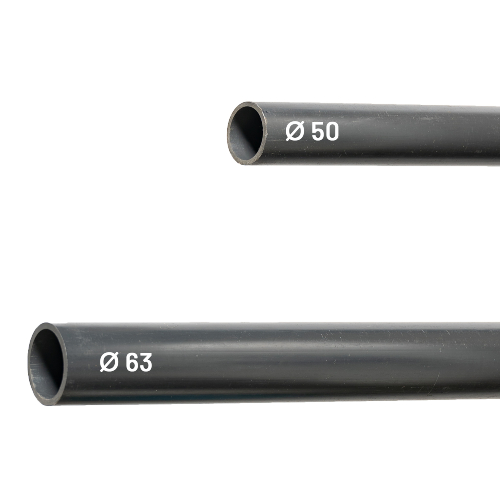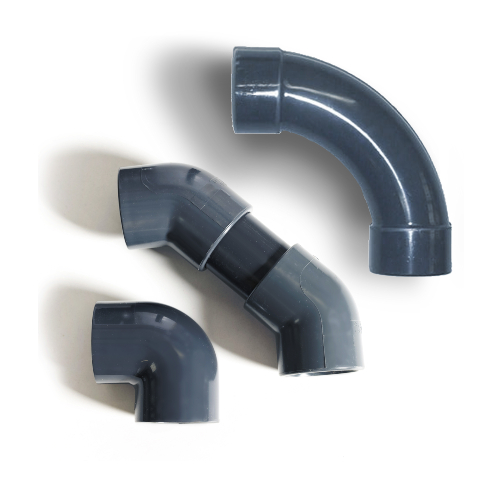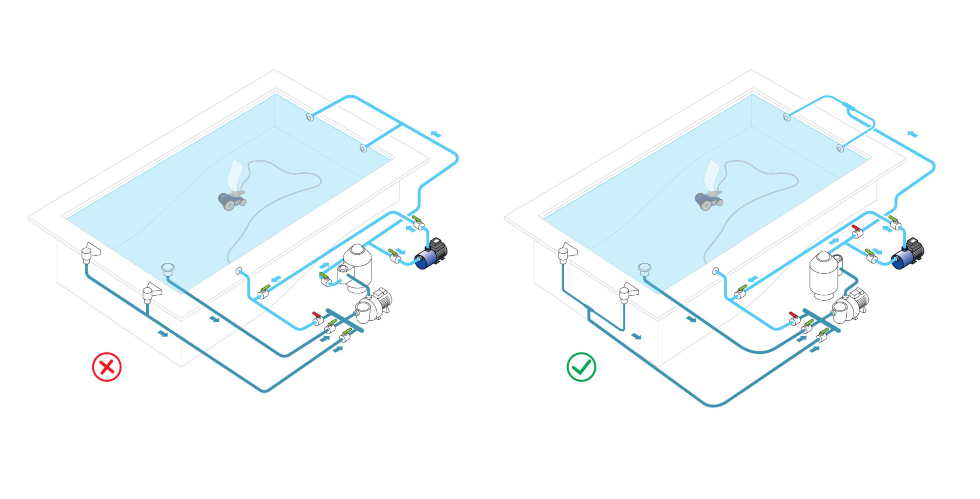
Pressure drop is a phenomenon experienced when water progresses through a circuit. It is essential to factor it in when designing a pool’s hydraulic network, to ensure proper water filtration and efficient operation of the pool.
- The flow rate of the water in the filtration system
- What is a pressure drop?
- Designing a pool to avoid pressure drops
- Correcting an excessive pressure drop problem
- Maintenance to prevent pressure drop problems
- Pressure drops in summary
The flow rate of the water in a pool’s filtration system
It is widely known that the main function of a swimming pool’s hydraulic system is to filter the water. This system, consisting of skimmers, nozzles, pipes, control valves, a pump, one or more filters, etc., must allow water to be filtered under the best possible conditions, as it carries out 80% of the cleaning of a pool.
In order for the central element of this system, the filter, to have maximum efficiency, the water must pass through it at the optimum speed and therefore with the optimum flow rate.
To ensure this optimum flow rate, the filtration pump is obviously essential, but it does not do everything. Equally important is the sizing of the pipes between the pool and the technical room i.e. their length, material and diameter as well as the number of parts to be sealed.
The correct installation of these elements helps to avoid pressure drops as much as possible by maintaining the water flow rate necessary for the proper filtration of the swimming pool water while keeping it clean.
What is a pressure drop?
A pressure drop is a physical phenomenon inherent in any water circuit: it is a reduction in energy, and therefore of flow rate, that impacts water when an obstacle is in its path. This obstacle can be of two types:
-
a linear pressure drop occurs over the entire length of a pipe: this is simply the friction of the water in the pipes,
-
a singular pressure drop occurs at a particular location. For example, a very tight 90° elbow that suddenly changes the water direction in the network can reduce the flow rate.
The pressure drop of a hydraulic network is thus the sum of the linear and the singular drops.
Poorly controlled pressure drops not only reduce the flow rate of water and therefore the efficiency of its filtration, they can also cause damage, sometimes serious, to the hydraulic network.
Designing a pool to avoid pressure drops
After making the right calculations, we can design a hydraulic network that minimizes pressure drops in order to obtain the desired water flow rate and speed - this is the most important step in the design of the swimming pool.
This step is crucial because, while changing a filter or a pump is a relatively simple operation, modifying an entire system after construction is a major task. It is best to design an efficient network from the outset, which does not skimp on pipes, control valves, etc. and will ensure the proper functioning of the swimming pool.
The speed of the water and the distance it travels
More generally, a very effective way of reducing pressure drops is to reduce water speed. This can be done by installing pipes of sufficiently large diameter (63 mm instead of 50 mm for example), to obtain a speed ideally between:
- 0.5 and 2 m/s - ideally 1.5 m/s - in suction,
- lower than 3 m/s - ideally 2 m/s - at discharge.

While allowing good water circulation between the swimming pool and the technical room, these speeds also prevent cavitation (i.e. the formation of microbubbles of water vapour at suction). This phenomenon increases exponentially with the speed of the water and, in addition to a large reduction in energy, can cause very significant damage to the pump turbine.
Finally, it is essential to avoid long distances between the swimming pool and the technical room, as the water experiences a linear pressure drop throughout the length of the pipes, which increases the risk of cavitation. Therefore, the technical room should ideally be placed as close as possible to the pool.
Changes of direction
Another good practice is to avoid sudden changes of direction in the pipes, for example two elbows of 45° will form much less of an obstacle to the water than one steep elbow of 90°. “Large radius” elbows are even more effective: they can be made using semi-rigid PVC pipes, for example producing a minimal energy drop.

The number of parts to be sealed
Finally, and especially at suction, it is advisable to select the number of parts to seal carefully: skimmers, nozzles, etc. These parts represent a low investment compared to the overall cost of the swimming pool. Don't be tempted to underestimate the requirements here and take the risk that the swimming pool will not function properly, which will prove much more costly in the long run.
Good practices for pipes are therefore firstly the selection of the right number of parts to be sealed, followed by the right number of pipes and elbows of the right diameter, to achieve a speed ideally of 1.5 m/s at suction and 2 m/s at discharge respectively.

The pump and the filter
The pump must be placed as close as possible to the skimmers to reduce distances and therefore pressure drops. But while the pump is often front of mind when designing a swimming pool, its only function is to serve the filter. It is the latter that should be the focus once the volume of swimming pool water to be treated has been defined.
The filter also has an influence on pressure drops: typically, a cartridge filter will cause less pressure drop than a sand filter. And contrary to popular belief, a well-sized cartridge filter requires little more maintenance than a sand filter - and is more efficient. The benefits speak for themselves!
Correcting an excessive pressure drop problem
It is much easier to design a filtration system at the outset that anticipates and minimises pressure drops than to fix the problems they can cause.
But sometimes intervention is necessary on a poorly designed pool: when the filtration system tries for example to pass a large flow rate of water through pipes that are too small.
So how can this problem be solved? The radical solution is of course to completely dig up the network of pipes and replace them according to the principles explained above. Effective but costly!
Before taking such drastic action, consider installing a filter that generates less pressure drop. Switch from a sand filter to a cartridge filter for example, as mentioned above.
Another solution might be to install a variable speed pump, to circulate the swimming pool’s hydraulic system more slowly when conditions allow, since a reduced speed produces fewer pressure drops. Make sure that the correct calculations and estimates have been made first to ensure sufficient water renewal in all cases.
Also, in the technical room, it is sometimes possible to modify certain pipes and elbows: replace 50 mm pipes by 63 mm pipes as well as elbows that are too tight by larger elbows.
Nevertheless, if the installation was poorly designed at the start, these changes may prove insufficient and a complete redesign of the filtration system may be the only option.

Maintenance to prevent pressure drop problems
We can also take action during the maintenance schedule to reduce pressure drops in the swimming pool circuit.
Indeed, filter descaling, carried out during wintering, is very important and valuable for both sand and cartridge filters.
This is because limescale in the filter can accumulate and create preferential paths that no longer filter the water at all, increasing the pressure and generating a pressure drop. In addition, limescale retains bacteria that then creates filter pollution, which can cause multiple problems with water quality.
For all these reasons, and not just the impact on pressure drops, it is strongly recommended that the filter be descaled at the end of each season.
Pressure drops in summary
Pressure drops in a hydraulic network of a swimming pool are a phenomenon to be factored in right from the design phase of the pool. If they prove to be too large, the water is no longer effectively filtered and damage may occur in the pipes.
It is necessary to design a filtration system that has as few obstacles as possible utilising: large pipe diameters, large elbows, shortened distances and correct number of parts to be sealed. This will ensure an appropriate speed while guaranteeing the water flow rate required for its proper treatment and renewal.
Finally, the pump (ideally with a variable speed) as well as the filter (sand or cartridge) can also have a significant effect on the pressure drop of the system, as can the descaling of the filter at the time of maintenance.
Add new comment